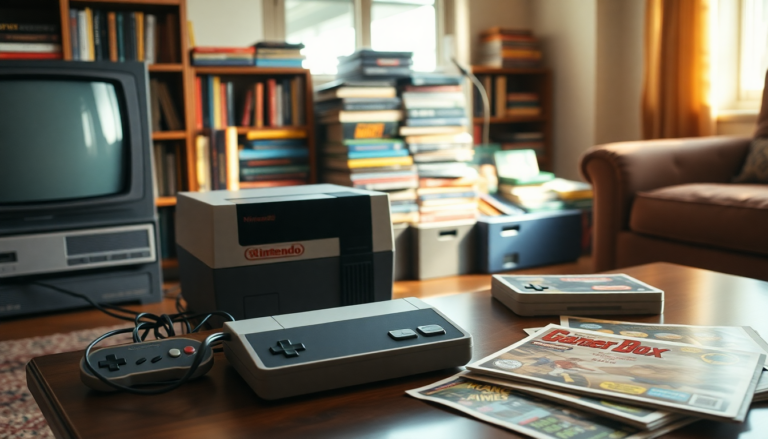Argomenti trattati
Who would have thought that a little gray box could change the world of gaming forever? The Nintendo Entertainment System (NES) not only reignited the gaming industry after its notorious crash in the early ’80s but also laid the groundwork for the modern gaming landscape we know today. Released in 1983 in Japan as the Family Computer, or Famicom, and arriving in North America in 1985, the NES became a household name, captivating the hearts of millions. It wasn’t just a console; it was a cultural phenomenon.
The genesis of the NES
The NES was born out of a vision from Nintendo’s president, Hiroshi Yamauchi, who sought to create a simple, affordable console capable of running popular arcade games. Designed by Masayuki Uemura, the NES featured a controller that echoed Nintendo’s earlier Game & Watch systems, marrying nostalgia with innovation. Interestingly, the console was reimagined for the Western market, cleverly disguised to resemble a VCR. This strategic move helped dispel the stigma around gaming consoles following the crash, presenting the NES as a sophisticated entertainment device.
Initially, the console was slow to gain traction, plagued by technical issues that led to product recalls. However, after a revamped model hit the shelves, the NES took off like a rocket. By 1984, it had become Japan’s best-selling console, marking the beginning of what is now referred to as the “Famicom Boom.” It’s fascinating to think about how a few tweaks in design and functionality could turn a failing product into a blockbuster success—reminds me of a time when I tried to fix my old gaming console and ended up creating something completely unexpected!
Influential titles and franchises
The NES isn’t just remembered for its hardware; it was the birthplace of iconic franchises that continue to thrive today. Titles like Super Mario Bros., The Legend of Zelda, and Metroid defined genres and set the standard for quality in gaming. I still recall my first experience with Super Mario Bros.; the thrill of navigating the Mushroom Kingdom was something truly magical. The way these games combined engaging storytelling with innovative gameplay mechanics was revolutionary—and the influence of these titles can still be felt in contemporary gaming.
What’s particularly noteworthy is how the NES pioneered the licensing model for third-party developers. Nintendo’s decision to allow external companies to create games for the platform led to a surge in creativity and diversity in gaming. Despite the strict regulations and fees imposed on developers, this model ultimately enriched the NES library, giving players countless hours of entertainment. And let’s be honest, who hasn’t felt the addictive pull of battling through pixelated levels, trying to beat their high score?
The global footprint of the NES
While the NES dominated markets in Japan and North America, its journey in Europe was a bit rocky. Competing against the Sega Master System and various home computers, the NES struggled to establish a strong foothold. Nevertheless, it still managed to sell over 61 million units worldwide, a testament to its enduring appeal. It’s interesting to observe how different markets responded to the same product—almost like watching a movie in different cultures and seeing how the audience reacts differently!
In Brazil, the NES faced stiff competition from unlicensed clones, yet the legacy of Nintendo’s innovation persisted. Even in regions where official sales were low, the NES inspired countless imitators, showing just how far-reaching its influence was. I remember hearing stories of friends in Brazil who had to navigate their local gaming landscape filled with clones and adaptations—talk about resilience in the gaming community!
Technological advancements and challenges
The NES was not just a gaming device; it represented a significant leap in technology for home consoles. Its 8-bit architecture allowed for more complex games, while the innovative cartridge design made swapping games a breeze. However, it wasn’t without its issues. The infamous blinking red light, which indicated a problem with the 10NES lockout chip, became a common frustration for players. I can’t count the number of times I blew into my cartridges, convinced that was the magic fix. (Spoiler: it never really worked!)
This lockout chip was a double-edged sword, designed to prevent unlicensed games from being played on the NES. While it protected Nintendo’s interests, it also sparked a wave of creative solutions from developers trying to bypass it. The battles between Nintendo and unlicensed developers are almost legendary in the gaming world, showcasing a cat-and-mouse dynamic that continues in various forms today.
The NES legacy and beyond
Fast forward to today, the NES’s impact is undeniable. It not only transformed Nintendo into a household name but also set the stage for future consoles like the Super Nintendo Entertainment System (SNES) and beyond. The gaming landscape has evolved tremendously since the NES era, with advancements in graphics, storytelling, and online connectivity. Yet, the foundational principles established by the NES remain relevant. For instance, the importance of quality control and the relationship between console manufacturers and third-party developers are lessons that resonate in today’s industry.
As the gaming community celebrates milestones and anniversaries, the NES continues to hold a special place in the hearts of gamers. Recent nostalgia-driven releases, like the NES Classic Edition, prove that the love for classic gaming never dies. Personally, I believe that the NES will always serve as a reminder of the magic that can happen when creativity meets technology—after all, it turned countless living rooms into gateways to fantastical worlds.

